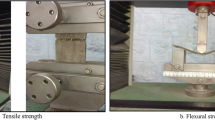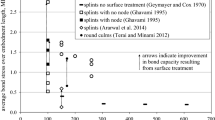Abstract
This study involved conducting a comparative experimental investigation to explore various techniques for rehabilitating reinforced concrete slabs. The initial phase of the experimental program consisted of testing seven reinforced concrete slabs with dimensions of 450 × 50 mm and a length of 1000 mm under line load. These slabs were divided into three groups. G.1served as the control group, comprising solid slabs without any rehabilitation. G.2 included three slabs that were rehabilitated using different methods, such as reinforcement rebars, steel plates, and textile straps with dimensions of 450 × 50 × 1 mm in the short direction and 1000 × 50 × 1 mm in the long direction. G.3 comprised three slabs rehabilitated with various types of geogrids, namely uniaxial, biaxial, and triaxial. To validate the experimental findings, a nonlinear finite element analysis (NFEA) was carried out using the Abaqus program. The test results indicated that the most effective, straightforward, and cost-efficient rehabilitation technique involved using an 8 mm diameter reinforced bar mesh, resulting in a 74.10% increase in load capacity and an acceptable level of stiffness. Slabs rehabilitated with steel plates and textile straps demonstrated load capacity increases of 4.32% and 9.35% respectively, compared to the control slab's ultimate capacity, while maintaining an acceptable level of stiffness. However, slabs rehabilitated with geogrids, particularly those using biaxial geogrid, exhibited load capacity increases of up to 15.83% compared to the control slab's ultimate capacity. The slab rehabilitated with triaxial geogrid demonstrated a load capacity increase of 7.91% compared to the control slab's ultimate capacity, along with an acceptable level of stiffness.



















































Similar content being viewed by others
Data availability
The database generated during the current study are available on reasonable request from the corresponding author.
References
Abu-Farsakh, M. Y., Akond, I., & Chen, Q. (2015). Evaluating the performance of geosynthetic-reinforced unpaved roads using plate load tests. International Journal of Pavement Engineering, 17, 901–912.
Agbossou, A., Michel, L., Lagache, M. Hamelin, P. (2008) Strengthening slabs using externally-bonded strip composites: analysis of concrete covers on the strengthening. Composites: Part B 39(7–8), 1125–1135.
Ahmed, M., Mallick, J., & Hasan, M. A. (2016). A study of factors affecting the flexural tensile strength of concrete. Journal of King Saud University-Engineering Sciences., 28(2), 147–156.
Aksoylu, C. (2021). Experimental analysis of shear deficient reinforced concrete beams strengthened by glass fiber strip composites and mechanical stitches. Steel and Composite Structures, an International Journal., 40(2), 267–285. https://doi.org/10.12989/scs.2021.40.2.267
Aksoylu, C. (2022). Shear strengthening of reinforced concrete beams with minimum CFRP and GFRP strips using different wrapping technics without anchoring application. Steel and Composite Structures., 44(6), 845–865. https://doi.org/10.12989/scs.2022.44.6.845
Aksoylu, C., Özkılıç, Y. O., Hadzima-Nyarko, M., Işık, E., & Arslan, M. H. (2022). Investigation on improvement in shear performance of reinforced-concrete beams produced with recycled steel wires from waste tires. Sustainability, 14, 13360. https://doi.org/10.3390/su142013360
Aksoylu, C., Ozkilic, Y. O., Yazman, Ş, Alsdudi, M., Gemi, L., & Arslan, M. H. (2023). Numerical and analytical investigation of parameters influencing the behavior of shear beams strengthened by CFRP wrapping. Steel and Composite Structures., 47(2), 217.
Anas, S. M., Alam, M., & Umair, M. (2021). Experimental and numerical investigations on performance of reinforced concrete slabs under explosive-induced air-blast loading: A state-of-the-art review. InStructures, 31, 428–461.
Arslan, M. H., Yazman, Ş, Hamad, A. A., Aksoylu, C., Özkılıç, Y. O., & Gemi, L. (2022). Shear strengthening of reinforced concrete T-beams with anchored and non-anchored CFRP fabrics. InStructures, 39, 527–542.
ASTM C138/C138M-17a. (2017). Standard test method for density (Unit weight), yield, and air content (Gravimetric) of concrete. West Conshohocken, PA, USA: ASTMInternational.
ASTM C143/C143M. (2020). Standard test method for slump of hydraulic-cement concrete (p. 2020). West Conshohocken, PA, USA: ASTM International.
ASTM C231/C231M-17a. (2017). Standard test method for air content of freshly mixed concrete by the pressure method. West Conshohocken, PA, USA: ASTM International.
Asyraf, M. R. M., Hazrati, K. Z., Sheng, D. D. C. V., et al. (2023). Lignocellulosic sugar palm fibre-reinforced thermoplastic composites: Mechanical, thermal and dynamic mechanical properties. Fibers Polym, 24, 2625–2639. https://doi.org/10.1007/s12221-023-00224-6
British Standards Institution (BSI). (2009). Testing hardened concrete: Compressive strength of test specimens, BS EN 12390–3. London, UK: BSI.
British Standards Institution (BSI). (2011). Cement: Composition, specifications and conformity criteria for common cements; BS EN 197–1. London, UK: BSI.
Cuong-Le, T., Le-Minh, H., & Sang-To, T. (2022). A nonlinear concrete damaged plasticity model for simulation reinforced concrete structures using ABAQUS. Frattura Ed Integrità Strutturale, 59, 232–242.
Dharanidharan, S. (2016). Flexural behaviour of ferrocement composite slab. International Journal of Engineering Sciences & Research Technology, 5(10),726
Dragoş Banu, N. Ţăranu (2010) " Traditional solutions for strengthening reinforced concrete slabs " buletinul institutului politehnic din iaşi, Universitatea Tehnică „Gheorghe Asachi” din Iaşi, Tomul LVI (LX), Fasc. 3, 2010
E.C.P.203/2007. (2007). Egyptian code of practice: Design and construction for reinforced concrete structures. Egypt.
Egyptian Standard Specification (ESS). (2009). Composition, specifications and conformity criteria for common cements; 4576–1. Cairo, Egypt: Egyptian Organization for Standards and Quality (EOS).
El-Samny M.K., Ezz-ELdeen H.A. and Elsepahy M.S. (2018) " Strengthening of reinforced concrete beams with openings " Al-Azhar University Civil Engineering Research Magazine (CERM), Vol. (40) No. (3) 2018.
Fares, A., Hassan, H., & Arab, M. (2020). Flexural behavior of high strength self-compacted concrete slabs containing treated and untreated geogrid reinforcement. Fibers. https://doi.org/10.3390/fib8040023
Finckh, W., & Zilch, K. (2012). Strengthening and rehabilitation of reinforced concrete slabs with carbon-fiber reinforced polymers using a refined bond model. Computer-Aided Civil and Infrastructure Engineering, 27(2012), 333–346. https://doi.org/10.1111/j.1467-8667.2011.00752.x
Gherdaoui, M., & Guenfoud, M. (2018). Repairing reinforced concrete slabs by composite materials. Journal of Material and Environment Science, 9(2), 701–708. https://doi.org/10.26872/jmes.2018.9.2.77
Hind, M. K. H., Özakçab, M., & Ekmekyapar, T. (2016). “ A review on nonlinear finite element analysis of reinforced concrete beams retrofitted with fiber reinforced polymers” department of civil engineering, university of gaziantep, 27310 Gaziantep, Turkey. Journal of Advanced Research in Applied MechanicsMaterials, 22(1), 13–48.
Naghibdehi, MGh., Sharbatdar, M. K., & Mastali, M. (2014). Repairing reinforced concrete slabs using composite layers. Materials and Design, 58, 136–144.
Özkılıç, Y. O., Beskopylny, A. N., Stelmakh, S. A., Shcherban, E. M., Mailyan, L. R., Meskhi, B., Chernilnik, A., Ananova, O., Aksoylu, C., & Madenci, E. (2023). Lightweight expanded-clay fiber concrete with improved characteristics reinforced with short natural fibers. Case Studies in Construction Materials., 19, e02367.
Tang, X., Chehab, G. R., & Palomino, A. (2008). (2008) “Evaluation of geogrids for stabilizing weak pavement subgrade.” International Journal of Pavement Engineering, 9, 413–429.
Yıldızel, S. A., Özkılıç, Y. O., Bahrami, A., Aksoylu, C., Başaran, B., Hakamy, A., & Arslan, M. H. (2023). Experimental investigation and analytical prediction of flexural behaviour of reinforced concrete beams with steel fibres extracted from waste tyres”. Case Studies in Construction Materials., 19, 02227.
Funding
The authors have not disclosed any funding.
Author information
Authors and Affiliations
Contributions
First author: collecting the data second author: Conducting the experimental works Third author: They conducted the theoretical part and created a complete conception of the paper
Corresponding author
Ethics declarations
Conflict of interest
The authors declare no competing interests.
Additional information
Publisher's Note
Springer Nature remains neutral with regard to jurisdictional claims in published maps and institutional affiliations.
Rights and permissions
Springer Nature or its licensor (e.g. a society or other partner) holds exclusive rights to this article under a publishing agreement with the author(s) or other rightsholder(s); author self-archiving of the accepted manuscript version of this article is solely governed by the terms of such publishing agreement and applicable law.
About this article
Cite this article
Mabrouk, I., Mahmoud, M.H. & Bushnaq, M.M. The process of rehabilitating reinforced concrete slabs using various materials such as steel bars, steel plates, textiles, and different types of geogrids. Asian J Civ Eng (2024). https://doi.org/10.1007/s42107-024-01067-z
Received:
Accepted:
Published:
DOI: https://doi.org/10.1007/s42107-024-01067-z




